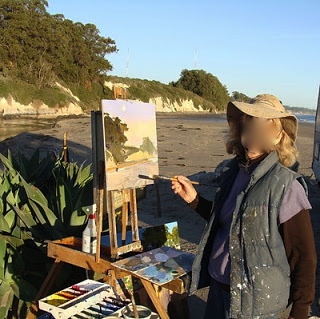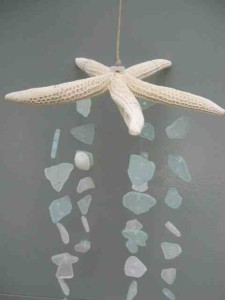GLOUCESTER—Starting in July, concerned Gloucester residents will try out a new program for managing a pervasive and seemingly intractable social ill.
“This addiction is tragic—and it’s a blight on our city,” said Dorothy Pendleton, president of the Rocky Neck Art Colony, one of several local groups supporting the experimental initiative. “But rather than stigmatizing the victims, we’ll give them the help they need.”
Pendleton delivered her remarks on Tuesday at the Cultural Center at Rocky Neck, where artists and other representatives from Gloucester’s creative class had gathered to announce their plan.
“I know all too well how easy it is to slide into a fixation on nautical themes and marine imagery in one’s art,” she told the audience, which responded with a chorus of amens.
“It starts with a lighthouse, a lobster trap, or a gaily colored dinghy bobbing in the harbor,” she said, her voice rising to a fever pitch. “And you think, Just this once. Just to score some easy cash.”
 [The grim consequences of addiction]
[The grim consequences of addiction]
Pendleton trained as a sculptor at Montserrat College of Art, graduating with her BFA in 1977. For years she occupied a studio on Rocky Neck, where she produced sleek, minimalist works in aluminum and epoxy.
But when the market for such conceptual sculpture collapsed in the mid-1980s, things went downhill.
She explained: “On a lark, I used some leftover resin to fashion a stylized anchor. It was hideous—and just so cliché. But I hung it in the window, and a buyer walked in the same afternoon.”
“That was my gateway to homogenous beach art,” Pendleton said, shaking her head at the memory. “Within six months, I had sold off my old materials and begun to churn out whimsical mobiles from driftwood and sea glass.”
According to Daniel Sizemore, a painter and board member of Cape Ann Artisans, stories like hers are common, especially in Gloucester.
“Our city has a long and sordid history as a hotbed of maritime art,” he said, pointing at a framed print of two schooners skimming over a choppy green sea.
“Fitz Henry Lane was the original kingpin,” Sizemore said, his eyes narrowing. “With his rakish frock coat and luminous sunsets.”
Pendleton elaborated: “Lane and his minions established a culture of nautical addiction in this town. So it’s difficult to escape the motifs—coiled rope, billowing sails, mirror-calm coves lit by low-slung crescent moons—that have dominated the vocabulary of the Gloucester artist for almost two hundred years.”
 [Lane, plotting the consolidation of his artistic cartel]
[Lane, plotting the consolidation of his artistic cartel]
Others place the blame on the steady stream of money coming across the Piatt Bridge.
“We wouldn’t see this habit-forming behavior if it weren’t so lucrative,” said Dexter Gee, a member of the Gloucester Arts Guild and a recovering photographer of the relentlessly pounding surf.
He explained: “Tourists from New York and Boston generate the demand. They come to Gloucester, waving their platinum cards, clamoring for low contrast images of breakers rolling onto Bass Rocks.
“And if the Twin Lights loom in the background, they’ll pay double or triple,” Gee continued, his shutter finger twitching restlessly. “For a photographer who’s barely getting by, it can be hard to resist.”
According to Pendleton, the cumulative effects on a community can be devastating. “Rocky Neck Avenue is starting to look like the hallway of a Motel 8 in Ocean City,” she said.
Sizemore admitted that for years he and other artist-vigilantes had tried to shame the creators of maritime kitsch into reforming their ways. “We’d drive to their known hangouts—the Back Shore, Eastern Point—and heckle them as they captured the sunlight staining the clouds crimson.”
But it never worked—and now, rather than shunning the nautically obsessed, Pendleton and her partners are extending a sympathetic hand.
“We are inviting all affected artists to come down to the Cultural Center here on Wonson Street,” she said. “And with no judgment whatsoever, we’ll begin the rehabilitation process together.”
That process entails the safe disposal of finished beach art, as well as any associated paraphernalia. Pendleton listed some possibilities: “Watercolor sets, moveable easels, and floppy straw hats for those tawdry plein air sessions.”
 [Image obscured to protect privacy]
[Image obscured to protect privacy]
Gee elaborated: “The Cultural Center will also pair you with a patron from the community who has agreed to purchase your first piece of clean, cliché-free work.”
“It could be almost anything,” he said. “An abstract canvas. A photo of a squalid gutter. Heck, even a naturalistic portrait.”
“Except no hoary sea captains,” Pendleton interjected.
Gee confirmed that their program is based on other local initiatives, which have used a compassionate approach to successfully address more significant addictions.
“If it can work for black tar heroin,” he said, “then there’s a chance it might work for pastel-tinted nautilus shells.”
Most exciting of all, according to Pendleton, is the potential for growth beyond Gloucester. Artists’ collectives throughout the region have expressed interest in the plan’s radical, outside-the-box methodology.
“We’re getting calls from lots of seaside towns struggling with the same issue,” Pendleton said. “Apparently, the compass rose is absolutely rampant on Cape Cod.”
Gee described just one disappointment with the plan’s design and execution thus far. “We approached the Rockport Art Association as a potential partner,” he said. “But they insisted their town doesn’t have a problem. In their minds, the addiction is ‘only a Gloucester thing.’”





OMG
I am proud that Gloucester is leading the charge against this terrible scourge.
Almost as worrying to this reader is the confusion many writers have over a word borrowed from the French. A phrase or opinion that is over-used and lacking original thought is a cliché; the use of said phrase or thought is, however, clichéd.
Pedantically Yours, etc., etc.
It won’t work unless they get to the kids for early intervention. It starts with the shell necklaces and seaglass they sell off milk crates. That’s how they get hooked, then it’s just a sad spiral downward.